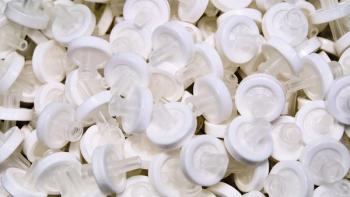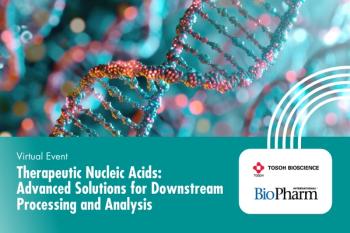
- BioPharm International, March 2022 Issue
- Volume 35
- Issue 3
- Pages: 21–23
Considering Purification and Separation in the Downstream Train
Emerging drug classes are giving rise to challenges in downstream processing, pushing the need for strategizing efficiencies.
The global downstream processing (DSP) market is predicted to experience compound annual growth rate of 16.09% between 2021 and 2027 (1). This market growth is reportedly being driven by the expanding biopharmaceutical industry and spending in medical research, the rising adoption of single-use technology in bioprocessing, and the swell of contract manufacturing organizations in the market for DSP (1).
To learn more about purification and separation of biopharmaceuticals, the fundamental challenges facing developers, ways in which companies can overcome bottlenecks associated with DSP, sustainability considerations, and other trends impacting this sector, BioPharm International spoke with Dorie Yontz, global market manager, Bioprocessing, DuPont Water Solutions, and Hans J. Johansson, global applications director, Purolite.
Techniques and technology overview
BioPharm: Could you provide an overview of the main techniques and technologies employed for separation and purification?
Yontz (DuPont Water Solutions): The type of DSP depends on the type of molecule. Most fermentation and cell culture processes start with some type of particulate separation system (centrifugation or depth filtration) to separate cells from the product in the liquid continuous phase. This is followed by a primary purification step to separate and concentrate the target drug from the bulk of the impurities in the dilute feed. In monoclonal antibodies (mAbs), this is an affinity chromatography step in which the product is captured. In peptides and other fermentation products, it may be an ion exchange or adsorptive chromatography step where product is captured based on its hydrophobicity. Additional polishing chromatography steps may be needed further downstream, which are designed to tackle the impurities via a different separation mechanism to the initial purification.
The choice of chromatography design is dictated by the nature of the impurities and the target product. Where there is a difference in ionic character in the impurities and the product, an ion-exchange chromatography (IEC) approach is preferred. Non-ionic species should be separated by hydrophobic interaction resins, or reverse-phase (RP) resins, depending on the polarity of the molecules and the carrier. In the case of synthetic oligonucleotides, which are a drug category that sits at the interface of conventional pharma and biopharma, either IEC or reverse-phase chromatography (RPC) can be used. In fact, RPC is the workhorse system that can achieve high resolution across a wide range of molecules.
Johansson (Purolite): Even if there are many technologies available today, chromatography based on different types of beads is instrumental for purification in a majority of downstream processes. For mAbs, a standard DSP platform based on Protein A affinity chromatography, followed by one or two additional polishing steps is generally adopted in the market. For other molecules there is less opportunity for general solutions, and, in many cases, no affinity-based solutions are available. In those cases, companies have to rely on putting together orthogonal resins based on size, charge, or hydrophobicity.
Fundamental challenges
BioPharm: What are the fundamental challenges of separation and purification?
Johansson (Purolite): There is an old saying that ‘the process is the product’. That is still true in many cases and results in a high threshold for introduction of new technologies. It is thus rare to see changes in established commercial processes. However, with the recent supply challenges where customers report delivery times well above a year for many chromatography resins, this might start to change. We have already seen initiatives in areas such as virus filtration and Protein A affinity chromatography to develop strategies for exchange of resins in registered processes.
Yontz (DuPont Water Solutions): The basic purpose of the DSP train is to provide a high-purity product stream at as high a yield as possible, in as short a time as possible, cost-effectively. In mature processes, particularly platform processes, purity has already been achieved and much of the focus is on throughput and cost-effectiveness. For new drugs, however, particularly those in the emerging drug classes, designing an effective purification scheme can be a challenge, and that is where drug developers work closely with experts, such as DuPont.
Particulate removal with mechanical filters such as depth filters or ultrafiltration is relatively straightforward because this primarily relies on size exclusion, but the separation of soluble species of similar nature is a much bigger challenge. Chromatography is an excellent technique for this because the purification mechanism relies on subtle differences in chemical and physical interactions between the soluble species and the resin. Luckily, there are many chromatography approaches and many degrees of freedom in chromatography variables, so drug developers have a variety of options for designing effective purification techniques.
Overcoming bottlenecks
BioPharm: How can companies overcome the bottleneck issues commonly associated with separation and purification?
Yontz (DuPont Water Solutions): Start-up procedures can be time-consuming, and ensuring processes can continue for as long as possible without having to change out or clean components, such as resins, helps improve speed in DSP.
For example, polymeric RP resin is much more stable than RP silica and can be more aggressively cleaned, extending the time between replacements while providing stable performance and a long lifetime.
Johansson (Purolite): There is an increasing interest in different types of continuous solutions based on multi-column systems. The primary goal is to increase productivity per liter of resin, allowing significant savings in resin and buffer volumes. This is especially relevant in clinical manufacturing where resins commonly are used for only a fraction of their functional lifetime. However, there will always be a balance between complexity, risk, and potential benefits. Thus, solutions that, from an engineering or scientific point of view, are most effective are not necessarily what end up being implemented.
Complex biomolecules
BioPharm: Is the increasing complexity of biomolecules impacting purification and separation?
Johansson (Purolite): While most plain mAbs fit well into existing DSP platforms, this is not always the case for next-generation antibodies that include conjugated, bispecific, and other novel molecule designs. For example, some new antibody-based biomolecules are more prone to aggregation under the acidic conditions used for elution from traditional Protein A resins. For that purpose, Purolite has recently launched a new resin that allows elution at 1–2 pH units above what is now needed to achieve complete recovery.
There has also been an increasing number of larger macromolecules reaching the market. The messenger RNA (mRNA)-based COVID-19 vaccines are an obvious example, but also virus, virus-like particles, and plasmids. The size of these molecules is a challenge for traditional resin design that depends on the diffusion in and out of the particles to achieve high capacities. There are ways to improve the performance of resin beads for these types of molecules, but we might also see an increasing use of other formats, such as nanofibers, monoliths, and membranes.
Yontz (DuPont Water Solutions): The complex drug pipeline will lead to a highly diversified product mix in the future. As therapies become more targeted, we expect to see a wide variety of drug structures. Researchers and manufacturers will need a portfolio of purification strategies, particularly in the chromatography area, to address the differing separation mechanisms, and this is where expert suppliers will be relied upon. The chemical and physical characteristic of oligonucleotides and peptides, for instance, favor separations via RPC, whereas other emerging drug categories may rely on hydrophobic interaction chromatography or affinity chromatography.
Often, we are trying to separate the target active compound from structurally similar impurities. This separation is a delicate balance of chemical and physical interactions with chromatography resin. Particle size, resin morphology, accessible surface area, resin chemistry, and mobile phase all influence resolution and separation kinetics. Platform processes will be more challenging in the future due to the increasing complexity of the drug pipeline, and there will be more focus on resin selection and designing the eluent system to meet the unique purification needs of each drug. Greater collaboration between researchers and resin suppliers will be needed.
Sustainable DSP
BioPharm: How might separation and purification be made more sustainable?
Yontz (DuPont Water Solutions): There is no ‘one size fits all’ as solutions have different benefits and trade-offs. Rather, it’s a matter of looking at the drug process as a whole and deciding which option is the better choice overall. Sustainability and environmental consciousness can come in many forms. For instance, the biopharma industry uses a tremendous amount of water, and, while the single-use trend can reduce water consumption from cleaning, that doesn’t change the fact that fermentation and cell culture processes are inherently water-intensive operations that produce a dilute product stream.
Anything in DSP that ensures high product yield also helps the sustainability picture by maximizing the total output of active drug substance each reactor provides. From that perspective, the most basic thing we look at when choosing the type of purification scheme is the yield. The type of chromatography (IEC, RPC, or adsorption chromatography) and the resin choice can be viewed as contributing to the overall sustainability of the system since it directly impacts product yield. In resin chromatography, there are several resin design aspects that relate to sustainability that we can improve upon.
Process intensification. The size of the column and the number of cycles needed to purify a batch play a key role in the amount of chemicals and solvent (organic solvents or water) that are used in the purification. The ideal resin is one that has good yield and purity at fast flow rates, which allows a smaller column to be used for a given process. Particle size, mechanical stability, and resin morphology all impact the separation kinetics of a resin system and, therefore, impact column sizing and chemical and solvent use.
Eluent profile. RPC relies on organic solvents for the eluent. On the surface, the solvent-based systems may seem counter to the sustainability and environmental trend, but that is not necessarily the case. RPC is a very effective and efficient chromatography technique. There have been several papers in recent years looking at alternative solvent choices to balance resolution and environmental profile and research into solvents from renewable sources (e.g., isobutanol, ethanol, isopropanol, acetone) continues in the bio-based chemical industry, with the hope of creating more sustainable solvent options in the future.
Resin lifetime. The first principle of ‘Green Chemistry’ is prevention, that is, avoiding waste, and resin lifetime directly relates to this. When designing resin chromatography systems, we should look for resins that can withstand many cleaning cycles and provide consistent performance batch after batch to extend the time between replacement. Polymeric resins are known to be stable to a wider pH range and can therefore be more aggressively cleaned for a longer lifetime compared to silica options.
Johansson (Purolite): Environmental footprint will certainly be important for all businesses in the nearby future. In DSP, there is the use for purification, where more efficient processes will require less resin, buffers, and energy but also the actual manufacturing of the resin. At Purolite we have a continuous way of manufacturing our agarose resins. That process reduces the carbon footprint, water, and solvent consumption by up to 80% compared to the traditional batch emulsification method that other manufacturers rely solely on.
Potential trends
BioPharm: Are there any particular trends for the future that you believe will be impactful for purification and separation?
Johansson (Purolite): Personalized medicine has been a topic for several decades now. It is a gradual development, but we have already seen some amazing developments. This will increase the pressure to lower cost of purification for very limited patient groups and, thus, small amounts of biopharmaceuticals. In DSP, the trend of increased use of pre-packed column, possibly pre/sterilized, will continue and also move down in scale. One could eventually see a future where specific antibodies are developed for single patients.
Another area is biosimilars. More and more biosimilars are coming to the market and regulatory pathways are developed in most regions over the world. With that comes an increasing pressure to further bring down cost of goods to make global supply possible.
Yontz (DuPont Water Solutions): I think we will see a tremendous growth in the need for oligonucleotide molecules to support the gene therapy market. These molecules do not fit the classic definition of biopharma because oligonucleotides are produced by chemical synthesis rather than fermentation or cell culture, but their mode of action is at the genetic level and involves specific, highly directed interactions in the body similar to that of biologic drugs.
Oligonucleotides have been under investigation for decades, but the segment has gained tremendous momentum in recent years. We should see an increase in RPC, particularly with polymer resins, as these processes scale to large-volume processes to tackle chronic diseases.
Reference
1. Market Research Future, Downstream Processing Market Information by by Technique (Cell Disruption, Solid-Liquid Separation, Clarification/Concentration, Purification Techniques, Formulation), by Product (Chromatography Columns & Resins, Filters, Membrane Adsorbers, other), by Application (Antibiotic Production, Hormone Production, Antibodies Production, Vaccine Production, Other), by End User ( Biopharmaceutical Manufacturers, Contract Manufacturing Organization, Other) Forecast till 2027, Market Report (September 2021).
About the Author
Felicity Thomas is the European editor for BioPharm International.
Article Details
BioPharm International
Vol. 35, No. 3
March 2022
Pages: 21–23
Citation
When referring to this article, please cite it as F. Thomas, “Considering Purification and Separation in the Downstream Train,” BioPharm International 35 (3) (2022).
Articles in this issue
almost 4 years ago
Outlining Cell Lines’ Future with Engineering Approachesalmost 4 years ago
Late-Stage Failures of Monoclonal Antibodiesalmost 4 years ago
Excipients for High-Concentration Biologicsalmost 4 years ago
Opportunities for Growth and Breakthroughs for Cell and Gene Therapiesalmost 4 years ago
Considering Blow-Fill-Seal for Biologic Drugsalmost 4 years ago
Empowering Protein Characterizationalmost 4 years ago
Selecting and Optimizing the Right Manufacturing Partneralmost 4 years ago
A Rocky Road Ahead for Commissioner Califfalmost 4 years ago
Characterizing the Unseen Drama of Analyticsalmost 4 years ago
The Importance of Batch Record Reviews During AuditsNewsletter
Stay at the forefront of biopharmaceutical innovation—subscribe to BioPharm International for expert insights on drug development, manufacturing, compliance, and more.





